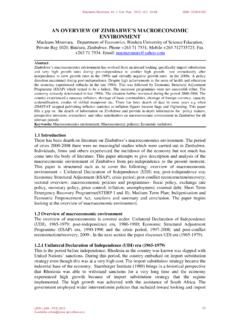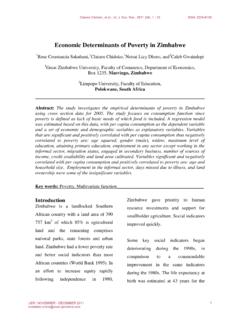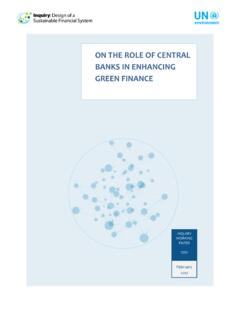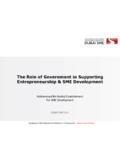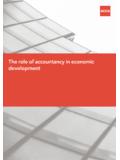Transcription of THE ROLE OF FINANCIAL INTERMEDIARIES IN ECONOMIC ...
1 the role OF FINANCIAL INTERMEDIARIES IN ECONOMIC development Tho Dinh Nguyen , Department of Economics and Business, Hatinh University 447 March 26 Street, Hatinh City, Vietnam, Email: Cell: +1 (347) 855-5889 ABSTRACT FINANCIAL INTERMEDIARIES together with FINANCIAL instruments and FINANCIAL markets play a major role in a FINANCIAL system. The development of FINANCIAL INTERMEDIARIES implies the progression of FINANCIAL systems, which obviously results in ECONOMIC development by mobilizing savings, funneling savings to investments and improving the allocation of capital as suggested by Pagano. In addition, FINANCIAL INTERMEDIARIES help reduce informational asymmetries problems through credit screening, delegated monitoring with optimal debt contracts with bankruptcy costs. Policy implications suggest FINANCIAL liberalization helps remove restrictions and FINANCIAL repression on FINANCIAL INTERMEDIARIES and stimulate ECONOMIC development .
2 Keywords: Credit, FINANCIAL INTERMEDIARIES , FINANCIAL System, Screening, Monitoring, ECONOMIC development JEL Classifications: O16, G21, E51, E58, O40 1. Introduction Schumpeter (1912) argues that FINANCIAL INTERMEDIARIES help improving capital allocation to encourage technological innovation by identifying and funding those entrepreneurs with profitable projects, hence promoting ECONOMIC development . FINANCIAL repression restricts the role of FINANCIAL INTERMEDIARIES and FINANCIAL liberalization increases the impact of FINANCIAL INTERMEDIARIES on ECONOMIC development (Goldsmith, 1969; Gurley and Shaw 1955, 1973; and McKinnon, 1973). Stiglitz and Weiss (1981) explain the role of FINANCIAL INTERMEDIARIES in assuming the role of credit screening to improve the credit allocation to low risk investment projects. Diamond (1984, 1996) and Williamson (1986a, 1986b, 1987) proposes the theory of FINANCIAL intermediation, explaining the delegation of credit monitoring to FINANCIAL INTERMEDIARIES would minimize the cost of monitoring information and resolve incentive problems between borrowers and lenders.
3 Credit screening and monitoring by FINANCIAL INTERMEDIARIES improve the capital allocation to improve the effective use of capital. Endogenous growth models contributed by Greenwood and Jovanovic (1990), King and Levine (1993), Levine (1997), Levine (1998) explain the relationship between the role of FINANCIAL INTERMEDIARIES and ECONOMIC development . Pagano (1993) provides an endogenous growth model, explaining the roles of FINANCIAL INTERMEDIARIES in ECONOMIC development through reducing transaction cost, increasing productivity, saving rates, investment rates. Diversification within an intermediary helps to reduce the cost associated with credit screening (Stiglitz and Weiss, 1981) and delegated monitoring (Diamond, 1984, 1996; and Williamson, 1986a, 1986b, 1987) and provide incentives for a FINANCIAL intermediary to deal with the problem of asymmetric information.
4 FINANCIAL INTERMEDIARIES would impact ECONOMIC development in different channels. Empirical Tho Dinh Nguyen, Res,2017,V8 i5,01 - 08 ISSN:2229-6158 IJER SEPTEMBER OCTOBER 2017 available online @ 1 investigations confirm the role of FINANCIAL INTERMEDIARIES on ECONOMIC development with some policy implications. 2. Theoretical reviews on the role of FINANCIAL INTERMEDIARIES in ECONOMIC development Assuming Kt is the aggregate capital stock and is depreciation rate per period, then the gross investment, It , is calculated as It = Kt+1 Kt(1- ); hence Kt+1 = It + Kt(1- ). The aggregate output, Yt, is calculated as Yt = AKt, where A is the social productivity of capital (Romer, 1989 and Lucas, 1988). Assuming the investment-savings ratio, , measured by the ratio of investment, It, devided by savings, St, and naming the saving rate S/Y, s, Pagano (1993) suggested the the steady-growth rate, gt+1, of the endogenous growth model, at period t+1, as follows.
5 Gt+1 = Yt+1/Yt 1 = (AKt+1)/(AKt) 1 = Kt+1/Kt 1 = [It + Kt(1- )]/Kt gt+1= It/Kt = ( St)/(Yt/A) = ASt/Yt - = As - In funneling savings into investment, FINANCIAL INTERMEDIARIES consume a certain proportion of total savings, 1- , in the form of spreads between borrowing and lending rates to cover the transaction costs, expected loans and defaults, or reserve requirements and taxation. FINANCIAL INTERMEDIARIES could increase the real investment rate by reducing the intermediation cost fraction 1- , and provide additional resources for ECONOMIC development . By effective allocation of capital to projects with high productivity and low risks, FINANCIAL INTERMEDIARIES help to increase the social productivity of capital, A. FINANCIAL INTERMEDIARIES may help improving the saving rate, s, to influence the ECONOMIC development by improving the quality of FINANCIAL services and reducing the transaction cost to narrow the spreads between borrowing and lending rates.
6 FINANCIAL INTERMEDIARIES play an important role in dealing with the problem of informational asymmetries. Informational asymmetries between lenders and borrowers make lending more costly and risky. FINANCIAL INTERMEDIARIES are capable of choosing the most appropriately high productive projects to extend loans. Economies of scales, expertise in the field, and available customer records for credit scoring and ratings help FINANCIAL INTERMEDIARIES have advantage over individual borrowers to assume delegated monitoring and screening role to cope with informational asymmetries Diamond (1984) uses a characterization of the costs to explain diversification within an intermediary FINANCIAL intermediation is a key to reduce the delegation costs of monitoring information through the incentives of debt contracts with costly bankruptcy. Diamond (1996) Tho Dinh Nguyen, Res,2017,V8 i5,01 - 08 ISSN:2229-6158 IJER SEPTEMBER OCTOBER 2017 available online @ 2 explains the key role of debt contracts using a simplified version of the model of Diamond model (1984) and confirms FINANCIAL technology, diversification within FINANCIAL INTERMEDIARIES , and the organizational form of INTERMEDIARIES help FINANCIAL INTERMEDIARIES play a key role in capital formation.
7 Williamson (1986a) uses a model with asymmetrically informed lenders and borrowers to demonstrate that intermediation dominates borrowing and lending between individuals to avoid duplication of efforts by individual lenders if monitoring is taken directly. Williamson (1986b) studies a general equilibrium model of imperfectly competitive FINANCIAL INTERMEDIARIES and confirms increasing returns to scale makes FINANCIAL intermediation an efficient mechanism for financing investment projects under asymmetric information. Asymmetric information normally leads to adverse selection and moral hazard. Prudential FINANCIAL INTERMEDIARIES do not normally extend loans to excessively risky projects. Stiglitz and Weiss (1981) demonstrates credit rationing can be an equilibrium feature of the market because of adverse selection and moral hazard. Credit rationing as a way of screening and monitoring potentially harmful investments can help enhance ECONOMIC development .
8 Dealing with moral hazard in credit markets can help reduce problems similar to the subprime mortgage crisis. Williamson (1987) develops a model with asymmetrically informed agents and costly monitoring of loan contracts. Instead of credit rationing, debt contract in equilibrium is an optimal solution to the adverse selection or moral hazard. Controls in the forms of inflation tax, high reserve requirements, compulsory holding of government bonds and inefficient interest rate ceilings far under equilibrium can create the problems of FINANCIAL repression to keep low or even negative real interest rates. McKinnon (1973) and Shaw (1973) suggest that FINANCIAL restrictions and repression in terms of a direct control over the FINANCIAL system such as high rates of the reserve ratios, a ceiling on the interest rate, government directives for banks to allocate credit at subsidized rates to specific firms and industries, nationalization of banks would discourages both saving and investment because the rates of return are lower than what could be obtained in a competitive market.
9 FINANCIAL repression hinders the development of FINANCIAL INTERMEDIARIES , which is known as the state of ' FINANCIAL shallow'; and obviously shrinks saving rates (Fry, 1995; Kitchen, 1986). In response to low real interest rates, households intertemporal choice would favor present consumption rather than future consumption, reducing savings and impeding ECONOMIC growth. Fry (1995) suggests FINANCIAL liberalization would release the problem of statutory credit rationing and alleviate burdens on FINANCIAL INTERMEDIARIES so that they would channel a larger Tho Dinh Nguyen, Res,2017,V8 i5,01 - 08 ISSN:2229-6158 IJER SEPTEMBER OCTOBER 2017 available online @ 3 amount of savings into investment. Liberalisation would reduce FINANCIAL restrictions and FINANCIAL repression by reducing taxes on FINANCIAL INTERMEDIARIES in terms of lowering reserve requirements, inflation taxes, transaction taxes, stamp duties, special tax rates on income from capital (The World development Report, 1989).
10 FINANCIAL liberalization and FINANCIAL deepening are a key to the problem. To stimulate ECONOMIC development , ceiling rates should be removed, inflation tax and other related obligations should be reduced (Shaw, 1973; McKinnon, 1973; Fry, 1995). Buckle and Thompson (1995) suggest FINANCIAL INTERMEDIARIES the most appropriate agents to play a role of risk sharing and transforming small deposits into larger loans. FINANCIAL INTERMEDIARIES can reduce specific or non-systematic risks (credit risk, price risk, liquidity risk) by diversification and market risk or systematic risks by prudent supervision and maintaining the stability of macroeconomic indicators. FINANCIAL INTERMEDIARIES help connecting risk-averse smaller depositors with larger riskier corporate borrowers. In this way, they enable potential entrepreneurs to invest in riskier and more productive technology.
